Zhihai He
Runge-Kutta Approximation and Decoupled Attention for Rectified Flow Inversion and Semantic Editing
Sep 16, 2025Abstract:Rectified flow (RF) models have recently demonstrated superior generative performance compared to DDIM-based diffusion models. However, in real-world applications, they suffer from two major challenges: (1) low inversion accuracy that hinders the consistency with the source image, and (2) entangled multimodal attention in diffusion transformers, which hinders precise attention control. To address the first challenge, we propose an efficient high-order inversion method for rectified flow models based on the Runge-Kutta solver of differential equations. To tackle the second challenge, we introduce Decoupled Diffusion Transformer Attention (DDTA), a novel mechanism that disentangles text and image attention inside the multimodal diffusion transformers, enabling more precise semantic control. Extensive experiments on image reconstruction and text-guided editing tasks demonstrate that our method achieves state-of-the-art performance in terms of fidelity and editability. Code is available at https://github.com/wmchen/RKSovler_DDTA.
Cross-Modal Few-Shot Learning with Second-Order Neural Ordinary Differential Equations
Dec 20, 2024Abstract:We introduce SONO, a novel method leveraging Second-Order Neural Ordinary Differential Equations (Second-Order NODEs) to enhance cross-modal few-shot learning. By employing a simple yet effective architecture consisting of a Second-Order NODEs model paired with a cross-modal classifier, SONO addresses the significant challenge of overfitting, which is common in few-shot scenarios due to limited training examples. Our second-order approach can approximate a broader class of functions, enhancing the model's expressive power and feature generalization capabilities. We initialize our cross-modal classifier with text embeddings derived from class-relevant prompts, streamlining training efficiency by avoiding the need for frequent text encoder processing. Additionally, we utilize text-based image augmentation, exploiting CLIP's robust image-text correlation to enrich training data significantly. Extensive experiments across multiple datasets demonstrate that SONO outperforms existing state-of-the-art methods in few-shot learning performance.
Domain-Conditioned Transformer for Fully Test-time Adaptation
Oct 14, 2024Abstract:Fully test-time adaptation aims to adapt a network model online based on sequential analysis of input samples during the inference stage. We observe that, when applying a transformer network model into a new domain, the self-attention profiles of image samples in the target domain deviate significantly from those in the source domain, which results in large performance degradation during domain changes. To address this important issue, we propose a new structure for the self-attention modules in the transformer. Specifically, we incorporate three domain-conditioning vectors, called domain conditioners, into the query, key, and value components of the self-attention module. We learn a network to generate these three domain conditioners from the class token at each transformer network layer. We find that, during fully online test-time adaptation, these domain conditioners at each transform network layer are able to gradually remove the impact of domain shift and largely recover the original self-attention profile. Our extensive experimental results demonstrate that the proposed domain-conditioned transformer significantly improves the online fully test-time domain adaptation performance and outperforms existing state-of-the-art methods by large margins.
Window-based Channel Attention for Wavelet-enhanced Learned Image Compression
Sep 21, 2024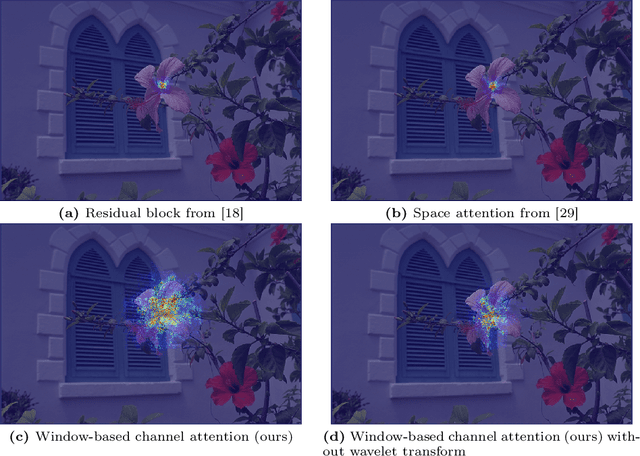
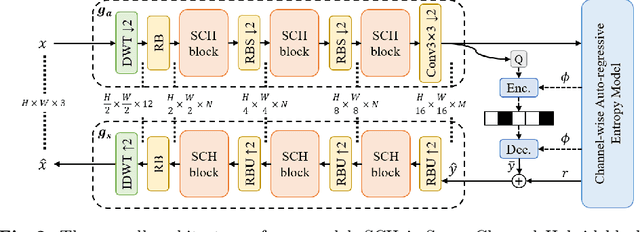
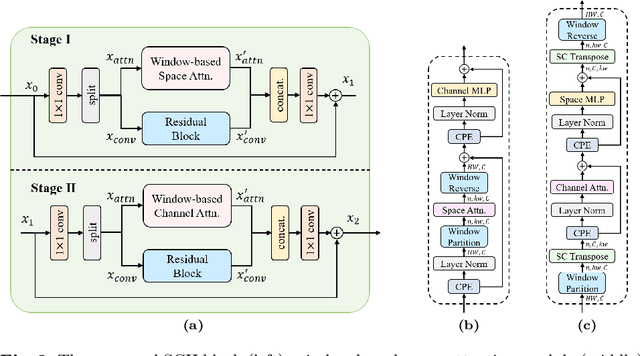

Abstract:Learned Image Compression (LIC) models have achieved superior rate-distortion performance than traditional codecs. Existing LIC models use CNN, Transformer, or Mixed CNN-Transformer as basic blocks. However, limited by the shifted window attention, Swin-Transformer-based LIC exhibits a restricted growth of receptive fields, affecting the ability to model large objects in the image. To address this issue, we incorporate window partition into channel attention for the first time to obtain large receptive fields and capture more global information. Since channel attention hinders local information learning, it is important to extend existing attention mechanisms in Transformer codecs to the space-channel attention to establish multiple receptive fields, being able to capture global correlations with large receptive fields while maintaining detailed characterization of local correlations with small receptive fields. We also incorporate the discrete wavelet transform into our Spatial-Channel Hybrid (SCH) framework for efficient frequency-dependent down-sampling and further enlarging receptive fields. Experiment results demonstrate that our method achieves state-of-the-art performances, reducing BD-rate by 18.54%, 23.98%, 22.33%, and 24.71% on four standard datasets compared to VTM-23.1.
Dual-Path Adversarial Lifting for Domain Shift Correction in Online Test-time Adaptation
Aug 26, 2024

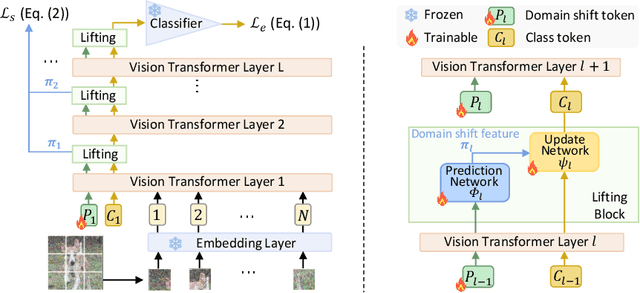
Abstract:Transformer-based methods have achieved remarkable success in various machine learning tasks. How to design efficient test-time adaptation methods for transformer models becomes an important research task. In this work, motivated by the dual-subband wavelet lifting scheme developed in multi-scale signal processing which is able to efficiently separate the input signals into principal components and noise components, we introduce a dual-path token lifting for domain shift correction in test time adaptation. Specifically, we introduce an extra token, referred to as \textit{domain shift token}, at each layer of the transformer network. We then perform dual-path lifting with interleaved token prediction and update between the path of domain shift tokens and the path of class tokens at all network layers. The prediction and update networks are learned in an adversarial manner. Specifically, the task of the prediction network is to learn the residual noise of domain shift which should be largely invariant across all classes and all samples in the target domain. In other words, the predicted domain shift noise should be indistinguishable between all sample classes. On the other hand, the task of the update network is to update the class tokens by removing the domain shift from the input image samples so that input samples become more discriminative between different classes in the feature space. To effectively learn the prediction and update networks with two adversarial tasks, both theoretically and practically, we demonstrate that it is necessary to use smooth optimization for the update network but non-smooth optimization for the prediction network. Experimental results on the benchmark datasets demonstrate that our proposed method significantly improves the online fully test-time domain adaptation performance. Code is available at \url{https://github.com/yushuntang/DPAL}.
NODE-Adapter: Neural Ordinary Differential Equations for Better Vision-Language Reasoning
Jul 11, 2024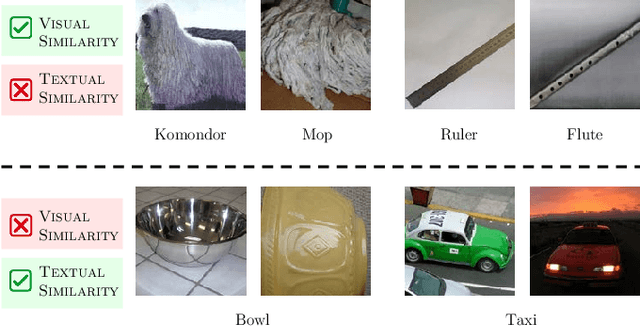
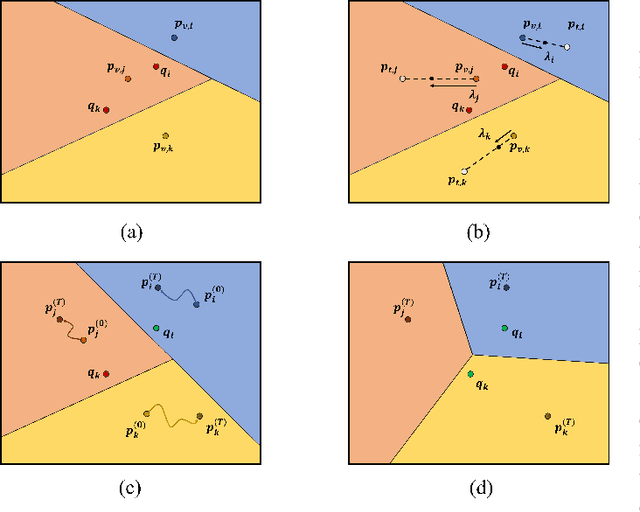
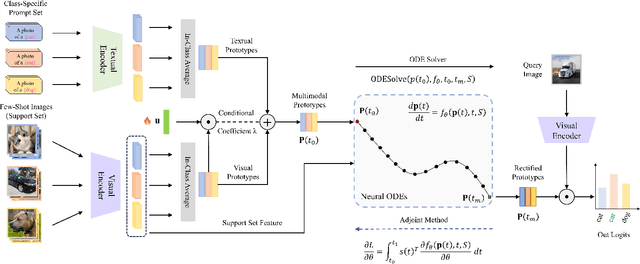
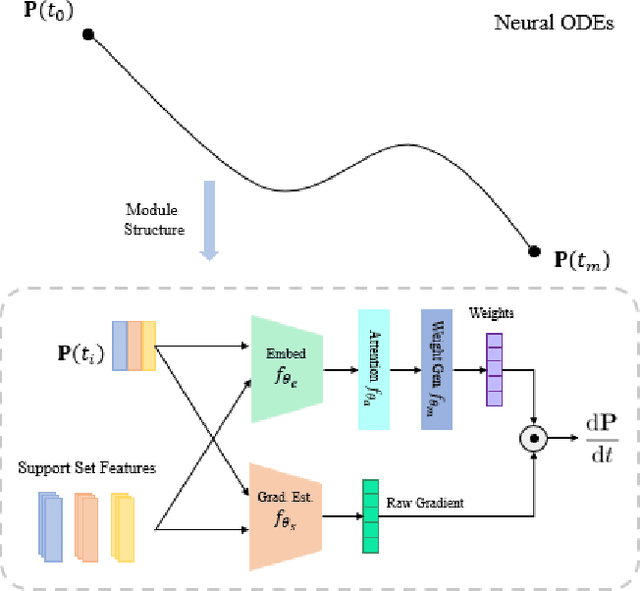
Abstract:In this paper, we consider the problem of prototype-based vision-language reasoning problem. We observe that existing methods encounter three major challenges: 1) escalating resource demands and prolonging training times, 2) contending with excessive learnable parameters, and 3) fine-tuning based only on a single modality. These challenges will hinder their capability to adapt Vision-Language Models (VLMs) to downstream tasks. Motivated by this critical observation, we propose a novel method called NODE-Adapter, which utilizes Neural Ordinary Differential Equations for better vision-language reasoning. To fully leverage both visual and textual modalities and estimate class prototypes more effectively and accurately, we divide our method into two stages: cross-modal prototype construction and cross-modal prototype optimization using neural ordinary differential equations. Specifically, we exploit VLM to encode hand-crafted prompts into textual features and few-shot support images into visual features. Then, we estimate the textual prototype and visual prototype by averaging the textual features and visual features, respectively, and adaptively combine the textual prototype and visual prototype to construct the cross-modal prototype. To alleviate the prototype bias, we then model the prototype optimization process as an initial value problem with Neural ODEs to estimate the continuous gradient flow. Our extensive experimental results, which cover few-shot classification, domain generalization, and visual reasoning on human-object interaction, demonstrate that the proposed method significantly outperforms existing state-of-the-art approaches.
Conceptual Codebook Learning for Vision-Language Models
Jul 02, 2024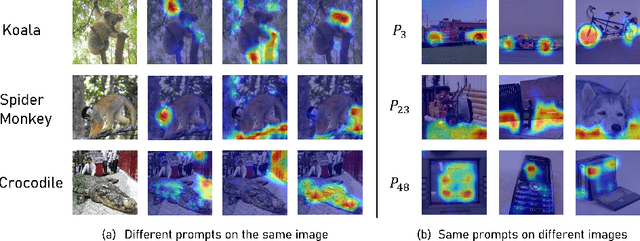
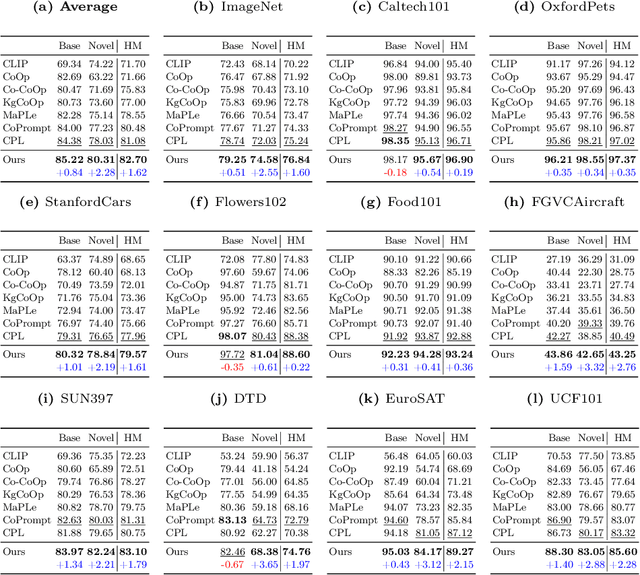
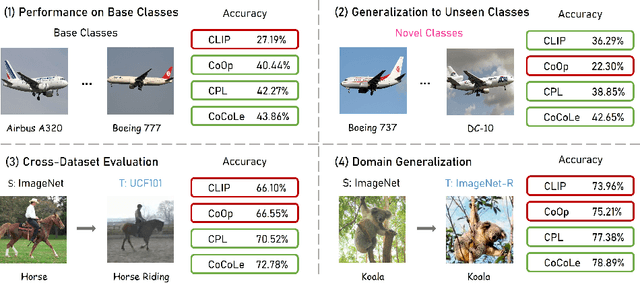
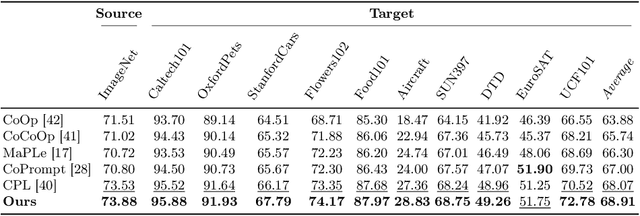
Abstract:In this paper, we propose Conceptual Codebook Learning (CoCoLe), a novel fine-tuning method for vision-language models (VLMs) to address the challenge of improving the generalization capability of VLMs while fine-tuning them on downstream tasks in a few-shot setting. We recognize that visual concepts, such as textures, shapes, and colors are naturally transferable across domains and play a crucial role in generalization tasks. Motivated by this interesting finding, we learn a conceptual codebook consisting of visual concepts as keys and conceptual prompts as values, which serves as a link between the image encoder's outputs and the text encoder's inputs. Specifically, for a given image, we leverage the codebook to identify the most relevant conceptual prompts associated with the class embeddings to perform the classification. Additionally, we incorporate a handcrafted concept cache as a regularization to alleviate the overfitting issues in low-shot scenarios. We observe that this conceptual codebook learning method is able to achieve enhanced alignment between visual and linguistic modalities. Extensive experimental results demonstrate that our CoCoLe method remarkably outperforms the existing state-of-the-art methods across various evaluation settings, including base-to-new generalization, cross-dataset evaluation, and domain generalization tasks. Detailed ablation studies further confirm the efficacy of each component in CoCoLe.
Learning Visual Conditioning Tokens to Correct Domain Shift for Fully Test-time Adaptation
Jun 27, 2024Abstract:Fully test-time adaptation aims to adapt the network model based on sequential analysis of input samples during the inference stage to address the cross-domain performance degradation problem of deep neural networks. This work is based on the following interesting finding: in transformer-based image classification, the class token at the first transformer encoder layer can be learned to capture the domain-specific characteristics of target samples during test-time adaptation. This learned token, when combined with input image patch embeddings, is able to gradually remove the domain-specific information from the feature representations of input samples during the transformer encoding process, thereby significantly improving the test-time adaptation performance of the source model across different domains. We refer to this class token as visual conditioning token (VCT). To successfully learn the VCT, we propose a bi-level learning approach to capture the long-term variations of domain-specific characteristics while accommodating local variations of instance-specific characteristics. Experimental results on the benchmark datasets demonstrate that our proposed bi-level visual conditioning token learning method is able to achieve significantly improved test-time adaptation performance by up to 1.9%.
Unsupervised Collaborative Metric Learning with Mixed-Scale Groups for General Object Retrieval
Mar 16, 2024



Abstract:The task of searching for visual objects in a large image dataset is difficult because it requires efficient matching and accurate localization of objects that can vary in size. Although the segment anything model (SAM) offers a potential solution for extracting object spatial context, learning embeddings for local objects remains a challenging problem. This paper presents a novel unsupervised deep metric learning approach, termed unsupervised collaborative metric learning with mixed-scale groups (MS-UGCML), devised to learn embeddings for objects of varying scales. Following this, a benchmark of challenges is assembled by utilizing COCO 2017 and VOC 2007 datasets to facilitate the training and evaluation of general object retrieval models. Finally, we conduct comprehensive ablation studies and discuss the complexities faced within the domain of general object retrieval. Our object retrieval evaluations span a range of datasets, including BelgaLogos, Visual Genome, LVIS, in addition to a challenging evaluation set that we have individually assembled for open-vocabulary evaluation. These comprehensive evaluations effectively highlight the robustness of our unsupervised MS-UGCML approach, with an object level and image level mAPs improvement of up to 6.69% and 10.03%, respectively. The code is publicly available at https://github.com/dengyuhai/MS-UGCML.
Concept-Guided Prompt Learning for Generalization in Vision-Language Models
Jan 15, 2024Abstract:Contrastive Language-Image Pretraining (CLIP) model has exhibited remarkable efficacy in establishing cross-modal connections between texts and images, yielding impressive performance across a broad spectrum of downstream applications through fine-tuning. However, for generalization tasks, the current fine-tuning methods for CLIP, such as CoOp and CoCoOp, demonstrate relatively low performance on some fine-grained datasets. We recognize the underlying reason is that these previous methods only projected global features into the prompt, neglecting the various visual concepts, such as colors, shapes, and sizes, which are naturally transferable across domains and play a crucial role in generalization tasks. To address this issue, in this work, we propose Concept-Guided Prompt Learning (CPL) for vision-language models. Specifically, we leverage the well-learned knowledge of CLIP to create a visual concept cache to enable concept-guided prompting. In order to refine the text features, we further develop a projector that transforms multi-level visual features into text features. We observe that this concept-guided prompt learning approach is able to achieve enhanced consistency between visual and linguistic modalities. Extensive experimental results demonstrate that our CPL method significantly improves generalization capabilities compared to the current state-of-the-art methods.
 Add to Chrome
Add to Chrome Add to Firefox
Add to Firefox Add to Edge
Add to Edge